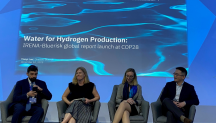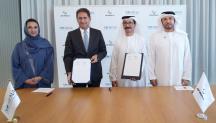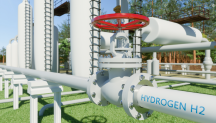

Countries Look to Advance Green Hydrogen Production for a Deep Energy Transformation
Newsletter
In a week in which Airbus, the world’s second largest aviation manufacturer, revealed prototypes for a hydrogen fuel passenger aircraft and a timeline for production to 2035, the International Renewable Energy Agency (IRENA) gathered global public and industry stakeholders to discuss how green hydrogen can advance towards cost competitiveness.
The first meeting of the Collaborative Framework on Green Hydrogen, held on 18 June 2020, emphasized the need to broaden external stakeholder participation, to build a deeper understanding of industry barriers and opportunities, and to form more cohesive and well-informed perspectives.
Welcoming new participants to the dialogue, the Hydrogen Council and the International Partnerships for Hydrogen for Fuel Cells in the Economy (IPHE), IRENA Director-General Francesco La Camera, noted the importance of building cooperation and support among the hydrogen community to mainstream green hydrogen in policy and investment decision making.
This was followed by the second meeting of the Collaborative Framework on Green Hydrogen, where Members acknowledged the key role green hydrogen can play in facilitating a low-carbon transition, including the importance of serving as a clean fuel for shipping, aviation, heavy industry, among others.
Investments in green hydrogen are undoubtedly growing and leading players made calls for enhanced cooperation to complement national efforts. Of Germany’s EUR 9 billion of investment earmarked for green hydrogen production, close to a quarter of it will support international cooperation, recognizing the potential need to import the fuel in large quantities as national policies stimulate demand.
Tim Karlsson, Executive Director of the IPHE highlighted that meaningful political and physical momentum is present today. “Hydrogen and fuel cells are a reality today,” he noted. “There is much more activity taking place than people realise,” pointing to the presence of more than 8,000 hydrogen cars on US roads. “The key question is how do we scale up the production, transportation, storage and use of hydrogen – especially clean hydrogen,” he said.
Economies of scale need standardisation according to H.E. Franz Michael Skjold Mellbin, Denmark’s Ambassador to the UAE and Permanent Representative to IRENA. He also stressed the importance of maintaining a strong global commitment to green hydrogen within the climate context. “We should avoid the potential of growing a green and a black hydrogen market in parallel,” he highlighted, saying production pathways could be decided by competing prices.
The cost reductions needed to make hydrogen competitive with fossil fuels remain contingent upon rapid and significant scale-up of its production. “By 2050, hydrogen could be a USD 2.5 trillion industry with a total workforce of 30 million people,” said Michele Azalbert, representing the Hydrogen Council.
Ms. Azalbert, who is also the CEO of Engie’s hydrogen business unit, said hydrogen will not only help to meet climate goals but will also contribute to realizing a more resilient and sustainable energy system.
On the basis of proposals by IRENA, Members agreed on the modalities for future meetings under the framework, including the selection of Morocco and the European Union as facilitator and co-facilitator of the future framework meetings.
One of the key areas identified by the Members was standards and the certification of green hydrogen. This is fundamental to enable a global trade, since all the CO2 emissions associated to hydrogen are in its production. It also allows differentiating green hydrogen from other production pathways to be able to value the lower greenhouse gas emissions. There are multiple initiatives ongoing and coordination is needed to ensure the definitions, thresholds, and scope are consistent across regions.
Standards and certification were the core topic of the first working-level session of the Collaborative Framework. This was organized as part of the World PtX Summit in Morocco in December 2020. The recording of the event can be watched online here. Experts from around the world were brought together to discuss the current status, identify gaps and define a potential way forward.
Some of the areas identified for further work include: how to ensure that the electricity is renewable when an electrolyser is connected to the grid, how to ensure the electricity used for hydrogen is additional and does not displace more efficient uses of electricity, cancellation of certificates when blending in the natural gas grid, among others. Some minimum considerations for a certification scheme were also defined including, for instance, the consistency with the certification of other carriers (electricity or gas) or the need to consider optional and mandatory sustainability criteria.
IRENA will continue to engage with Members tackling some of these issues, involving countries that are not part of other multi-lateral initiatives, building upon existing efforts, and the experience from certification of renewable electricity.
More information on green hydrogen can be found here.




